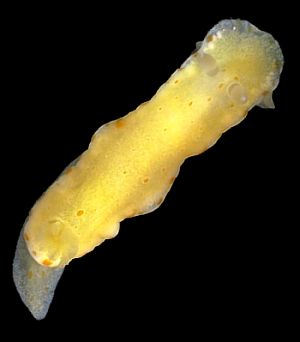
Noumea closei
Rudman, 1986
Order: NUDIBRANCHIA
Suborder: DORIDINA
Superfamily: EUDORIDOIDEA
Family: Chromodorididae
PHOTO
UPPER: Boat Harbour, Devonport, Tasmania; 1 specimen (16 mm long alive), 12m, 26 May 1985, AM C146610 - Holotype. LOWER LEFT: Horseshoe Reef, off Devonport, Tasmaania; 1 specimen (11mm long alive), 12 m, 19 February 1984, AM C141269. LOWER RIGHT: Warna Point, Louth Bay, Eyre Peninsula, South Australia; 8 specimens (5-7 mm long alive), 2 m, 11 February 1985, AM C145100. Food sponge is Darwinella sp. PHOTOS: Bill Rudman
RELATED TOPIC
The whole of the body is a uniform bright yellow, often slightly translucent in smaller specimens. There are a row of orange spots around the mantle, just in from the edge and a few scattered over the rest of the mantle. In some larger specimens the orange spots are bright and opaque while in many specimens they are more translucent. In most specimens there is a thin line of microscopic white specks right at the mantle edge and scattered white specks all over the mantle. In some specimens there are also aggregations of white specks forming a row of diffuse white patches down each side of the mantle from behind the rhinophores. In other specimens the white specks form a ring around the orange spots on the inner part of the mantle. The gills and rhinophores are a bright translucent yellow, the rhinophore club being tipped with white. Usually the underside is translucent yellow with no orange spots but sometimes there are a few orange spots forming a submarginal line along the side of the foot and around the posterior end.
The mantle is ovate with a distinct overlap and the body has a relatively low profile. The mantle glands are ovate globules forming a submarginal band around the mantle edge and are quite visible, especially in juvenile specimens. In one specimen a granular white secretion was extruded from the mantle glands through pores on the dorsal surface. The simple gills form a circlet around the anus in the postero-dorsal midline. The anterior edge of the foot is developed into a rounded foot corner on each side which extends beyond the mantle overlap when the animal is crawling.
This species is known from Victoria, Tasmania and South Australia and has been found on a bright yellow sponge of the genus Darwinella [previously mistakenly identified by me as Aplysilla sulphurea]. Both the sponge and the chromodorid go dark brown to black in preservative. This spectacular colour change is a useful way of separating N. closei from the very similarly coloured N. suphurea which also feeds on either the same, or closely related species of Darwinella, but does not darken on preservation, but gradually loses its colour.
At present N. sulphurea is known from New South Wales to Western Australia while N. closei is known only from Victoria, Tasmania and South Australia. While more intensive collecting in Western Australia may extend the known range of N. closei westward, the relatively extensive collecting which has been undertaken in New South Wales in recent years would suggest that it does not extend into that state. These two species, and the yellow colour form of Noumea haliclona form a group of similarly coloured sympatric species in southeastern Australia.
Reference:
• Rudman, W.B. (1986) The Chromodorididae (Opisthobranchia: Mollusca) of the Indo-West Pacific: Noumea flava colour group. Zoological Journal of the Linnean Society, 88: 377-404.
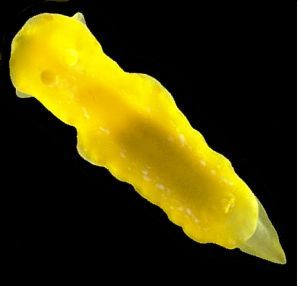
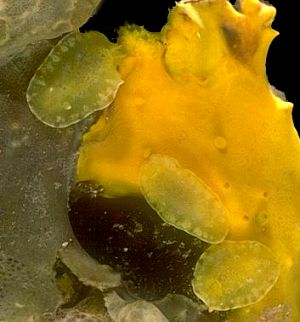
Rudman, W.B., 2001 (March 28) Noumea closei Rudman, 1986. [In] Sea Slug Forum. Australian Museum, Sydney. Available from http://www.seaslugforum.net/find/noumclos
Related messages
Re: Noumea closei from South Australia
July 25, 2005
From: Dennis Hutson
Hi Bill,
Sorry the locality data wasn't sufficient [#14265]. Locally we simply call this site "The Barge". The wreck may have had a name whilst in service but this information is unknown to me. This wreck is situated several km's offshore from the beach of a suburb called Glenelg. Local waters are Gulf St. Vincent. Thanks for your help.
Cheers
D.
dghutson@ozemail.com.au
Hutson, D., 2005 (Jul 25) Re: Noumea closei from South Australia. [Message in] Sea Slug Forum. Australian Museum, Sydney. Available from http://www.seaslugforum.net/find/14310Dear Dennis,
Thanks for the clarification - and the opportunity to explain again why I ask for full locality information. I used to hunt around in Atlases and on the web to clarify locality information - but the time I spend doing that is time I haven't got to spend on discussing animals.
Best wishes,
Bill Rudman
Re: Noumea closei from South Australia
July 21, 2005
From: Gary Cobb
Bill,
I have dived "The Barge" off the seaside town called "Glenelg" South Australia. A very popular site in this area. Home of Glenelg Scuba.
Cheers
Gary
gary@nudibranch.com.au
Cobb, Gary, 2005 (Jul 21) Re: Noumea closei from South Australia. [Message in] Sea Slug Forum. Australian Museum, Sydney. Available from http://www.seaslugforum.net/find/14300Dear Gary,
I thought there was a Glenelg down that way, but the wording of the message [#14265] was a bit ambiguous. As a general comment, locality data has been arriving in a much better form since we updated the form for submitting messages. As a rule of thumb, assume that people reading your message knows nothing of the geography of your region. I much prefer deleting unnecessary information than having to search atlases to find what ocean someone is talking about. And thanks Gary for bothering to let me know. I welcome any help, reporting of errors etc etc.
Best wishes,
Bill Rudman
Noumea closei from South Australia
July 20, 2005
From: Dennis Hutson
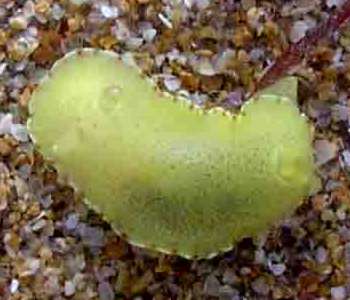
Could this please be identified and is it native to South Australian waters?
Locality: wreck of the barge, Glenelg, South Australia. Depth: 16 m. Length: 10 mm. 9 July 2005, Deck of the wreck, Photographer: Dennis Hutson
Cheers,
Dennis.
dghutson@ozemail.com.au
Hutson D.G., 2005 (Jul 20) Noumea closei from South Australia. [Message in] Sea Slug Forum. Australian Museum, Sydney. Available from http://www.seaslugforum.net/find/14265Dear Dennis,
Could you include a bit more locality data please? I assume Glenelg is the name of the wreck not the place?
This is Noumea closei, which is known from Victoria, Tasmania and South Australia. Have a look at the Fact Sheet for more information on it and the other similarly coloured species.
Best wishes,
Bill Rudman
Noumea closei from South Australia
March 10, 2002
From: Stuart Hutchison
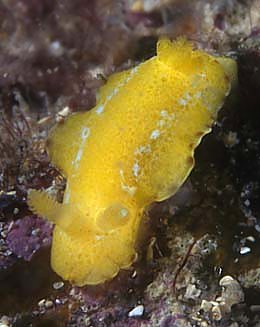
Hi Bill,
here's one were not sure about from the wreck of The South Australian, Adelaide, South Australia on 26 Sep 1999. Depth 20m, length 15mm.
Regards,
Stuart
stuart@stuarthutchison.com.au
Hutchison, S., 2002 (Mar 10) Noumea closei from South Australia. [Message in] Sea Slug Forum. Australian Museum, Sydney. Available from http://www.seaslugforum.net/find/6309Thanks Stuart,
I am pretty sure, from the white marks, that this is Noumea closei. However if you look at the Bass Strait colour form of Noumea sulphurea you will see it is almost identical externally. There is an interesting story attached to how I first realised there were two species involved. N. closei when preserved in formalin turns dark brown, sometimes almost black, while Noumea sulphurea gradually loses all its colour, becoming translucent white. One day when I was choosing some specimens to dissect I decided I had better check some dark and some light coloured ones just in case I had missed something. To my great surprise I found their radular morphology was quite different.
Using the preserved colour of a slug is not the most practical way to identify a species, but as with species of Rostanga, sometimes external shape and colour just isn't enough.
Best wishes,
Bill Rudman
